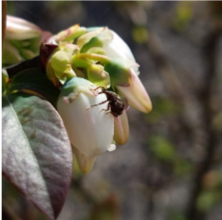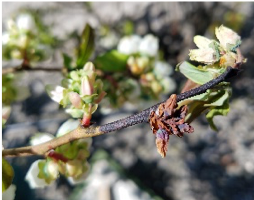Peach:
Oriental Fruit Moth: First generation timings are updated below:
| OFM 1st Degree Day (DD) Timing | ||||
| Insecticide Type | ||||
| County/Region | Biofix | DD by 5/1 base 45 | Conventional
170-200, 350-375 |
Diamide
100-150, 300-350 |
| Gloucester – Southern | 4/8 | 344 | 1st – past
2nd – 5/1-5/2 |
1st – past
2nd – 4/27-5/1 |
| Hunterdon – Northern | 4/16 | 173 | 1st – 5/1-5/2
2nd – about 5/12-16 |
1st – past
2nd – about 5/9-12 |
Plum Curculio (PC): PC adults usually begin egg laying once the fruit is out of the shuck. Preferred materials that offer PC control now are Avaunt, and Imidan. If using high rates of a neonicotinoid (i.e. Actara, Belay, Assail), be aware that there is a synergistic effect when used in tank mixes with DMI materials (i.e. Rally) with regard to bee toxicity. Neonicotinoids should not be used if there are any flowering weeds in your orchard. Those flowering weeds will attract bees, which will be killed by the insecticide. The use of most of these products when bees are present is off label and therefore not legal. If pyrethroids are being used, then high rates are advisable, since low rates often do not control PC, especially in hot weather. Where PC is a problem, growers should rotate away from pyrethroid insecticides if possible. Actara and Belay will also control PC (and GPA), but not OFM.
Green Peach Aphids (GPA): Green Peach Aphid: GPA colonies typically begin forming at bloom, however in southern counties aphids have yet to be seen in any significant numbers. If aphids are at treatment level, and your ground cover is clean of blooming weeds, a good choice that will cover catfacing insects, aphids, and plum curculio is Thiamethoxam (Actara and in VoliamFlexi). Actara alone will not control OFM. Examine trees for the presence of colonies by standing back and looking at the entire tree. Clusters of curled leaves will define a single colony. Count the number of colonies on ten trees and use a treatment threshold of 2 colonies/tree at petal fall to shuck split for peach, and 1 colony/tree for nectarine. If treating aphids alone then Movento @ 6 oz/A is a good non-neonicotinoid choice. Movento must be combined with a spreader/penetrant spray adjuvant. Used later during late May to early June this will also control scale. Movento will not control PC or catfacing insects. Lannate can also be used, but is not quite as effective and is a weak PC material.
Tarnished Plant Bugs and Other Catfacing Insects: This is the other key insect complex at this time of year. Tarnished plant bugs will become more of an issue as temperatures warm and mowing and other ground cover activities become more common. General spray timing at this time of year should still be targeted for Oriental Fruit Moth and/or Plum Curculio (PC).
Bacterial Spot: Maintain tight covers with antibiotics until pit hardening. Typical antibiotics used include various copper and oxytetracyclene formulations. Developing leaf infections were readily observed in every southern county orchard this past week. This infection occurred prior to the developing fruit being exposed, so there is no danger to the fruit. However, this does indicate that there is plenty of fresh inoculum for future fruit infections. Full covers with at least 100 gpa are recommended. See last week’s post for more information.
Peach Scab: Maintain good coverage with captan or other effective fungicides until July where scab was an issue last year.
Rusty Spot: Rusty spot infections are ongoing until pit hardening. Maintain coverage with effective materials such as Rally, Rhyme, or potassium bicarbonate products.
Apple:
Codling Moth (CM): The first codling moth flight has started. A biofix was set for CM on April 25th in southern counties and on May 1 in Hunterdon County.
| Codling Moth Degree Day Timing | ||||||||
| Application and Insecticide Type | ||||||||
| County Area | Biofix | Rimon:
75-100DD + 14-17 days later
|
Intrepid
150 + 450 DD Diamides – Altacor, Voliam mixes: (150-200 DD) + 14-21 days later |
Cyd-X, Madex
250 DD + every 7-9 days during brood hatch (later if first spray is an IGR) |
Standard Insecticides – Delegate, Avaunt, OP’s, carbamates, pyrethroids
250 DD + 550 DD
|
|||
| DD | 75 | 100 | 150 | 450 | 250 | 250 | 550 | |
| Southern | April 25 | 5/1 | 5/3 | 5/6 | Too far off | 5/12 | 5/12 | Too far off |
| Northern | May 1 | 5/8 | 5/12-13 | Too far off | Too far off | Too far off | Too far off | Too far off |
Tufted Apple Budmoth (TABM): A biofix for TABM was set in southern county orchards on 4/25. Nothing needs to be done for TABM at this point. More on TABM as we get closer to the first insecticide applications as predicted by the model.
Spotted Tentiform Leafminer (STLM): Adults are flying, but are not considered a pest target at this time. This is one of the most highly parasitized insects in the orchard. We have not seen a real problem with this insect in recent years. However in recent summers we have observed an increase in trap counts and injury in a few orchards in southern counties. Monitor your orchard for damage.
European Apple Sawfly (EAS): This insect is active through bloom and into petal fall and first cover. Adult females lay eggs just under the skin of freshly set fruit, and the young larvae mine just under the skin. Where present, it is a primary target at petal fall. In orchards of mixed variety plantings, the petal fall spray for the entire planting is prolonged. This enables EAS to start damaging the first varieties where petals fell earlier before a petal fall spray could be applied to the entire block. DO NOT SPRAY ANY INSECTICIDE DURING BLOOM FOR THIS PEST! Doing this will kill bees, hurt pollination and fruit set, and is highly illegal!
Diseases: Apple Scab, Powdery Mildew, Cedar Apple Rust, are diseases of concern at this time. The NEWA scab models are predicting about 59% ascospore maturity by 5/1 in southern NJ. Primary apple scab spores are released during any substantial wetting and infection period. Cedar apple rust infections can occur anytime between pink and 3rd cover.
Fire Blight: Continue antibiotic applications just prior to infection periods and up to 1st cover for shoot blight. If using Apogee or Kudos for shoot blight suppression follow label instructions. The full rate of Streptomycin can be reduced if combining with Regulaid or a glycerin spreader. Some blocks have mixed varieties that bloom at different times, and some varieties can have a prolonged or ‘rat-tail’ late bloom. This can provide challenges for fire blight control. Since we now have 4 antibiotic products, consisting of 3 active ingredients, rotations are now possible where extended management is needed. Do not use more than 2 consecutive applications of any one active ingredient. As with any product, there are restrictions. Labeled materials include the following:
| Material | Active Ingredient | Full Rate | Notes |
| Agri-Mycin | Streptomycin Sulfate | 48 oz/A, 24-32 oz w/ adjuvant | May be applied after petal fall. 50 days PHI – apple, 30 days – pear. |
| FireLine | Oxytetracycline Hydrochloride | 16 oz in 100 gal/A | Do not exceed 6 applications per season. May apply 1 application after petal fall. 60 days PHI. |
| Mycoshield | Calcium Oxytetracycline | 16 oz in 100 gal/A | Do not exceed 6 applications per season – apple or 10 applications – pear. 60 days PHI |
| Kasumin 2L | Kasugamycin Hydrochoride | 64 oz in 100 gal/A | Max 4 applications. Do not apply after petal fall. |
Scouting Calendar Tree Fruit Southern Counties
The following table is intended as an aid for orchard scouting. I t should not be used to time pesticide applications. Median dates for pest events and crop phenology are displayed. These dates are compiled from observations made since 1995 in Gloucester County. Events in northern New Jersey should occur 7-10 days later.
Pest Event or Growth Stage |
Approximate Date | 2019 Observed Date |
| Bud Swell (Redhaven) | March 23 +/- 15 Days | March 25 |
1/4″ Green Tip Red Delicious |
March 31 +/- 13 Days | March 27 |
Pink Peach (Redhaven) |
April 4 +/- 15 Days | April 4 |
Tight Cluster Red Delicious |
April 9 +/- 13 Days | April 8 |
Oriental Fruit Moth Biofix |
April 9 +/- 13 Days | April 8 |
Full Bloom Peach (Redhaven) |
April 9 +/- 14 Days | April 9 |
Pink Apple (Red Delicious) |
April 14 +/- 12 Days | April 16 |
Codling Moth Biofix |
April 27 +/- 13 Days | April 25 |
Green Peach Aphid Observed |
April 16 +/- 16 Days | Not yet observed |
Full Bloom Apple (Red Delicious) |
April 22 +/- 11 Days | April 20 |
Petal Fall (Redhaven) |
April 22 +/- 10 Days | April 19 |
Petal Fall (Red Delicious) |
April 27 +/- 14 Days | April 29 |
Shuck Split (Redhaven) |
April 30+/- 11 Days | April 24 |
First PC Oviposition Scars Observed |
May 3 +/- 18 Days | April 23 |
Tufted Apple Bud Moth Biofix |
May 4 +/- 10 Days | April 8 |
San Jose Scale Crawlers |
June 2 +/- 8 Days | Not yet observed |
Pit Hardening Peach |
June 16 +/- 8 Days | Not yet observed |
Tree Fruit Trap Counts – Southern Counties
| Weekending | STLM | TABM-A | CM | AM | OFM-A | DWB | OFM-P | TABM-P | LPTB | PTB |
| 4/27/2019 | 8 | 1 | 3 | 110 | 29 | 0 |
Tree Fruit Trap Counts – Northern Counties
| Weekending | STLM | TABM-A | CM | AM | OFM-A | DWB | OBLR | OFM-P | TABM-P | LPTB | PTB |
Blueberry
Plum Curculio (PC) – PC adult counts have increased from last week. We are capturing PC in both organic and conventional fields. During the past week, all captures were found in Atlantic County. This week’s average for PC were 0.06 per bush with a max of 1.5 per bush. There is nothing anybody can do for this insect until the bees are out. Scouting does give you an idea about where the highest populations are, and where can be concentrated when insecticides start up again.

Plum curculio adult on blueberry flower (C. Denson).
Leafroller (LR) – Counts of leafroller larvae and other Leps (Lepidopteran pests – moths and butterflies) increased over the past week. In addition to leafroller larvae, we see a number of spanworms and green fruitworm larvae. Average counts were .02 larvae per bush with a maximum of .5 larvae per bush. This is well below the treatment threshold of 1 larva per bush.
Sawfly larvae are also present in a few fields. A sawfly is a type of wasp and not related to moths and butterflies. Therefore the materials that can be used during bloom to target moth and butterfly larvae, such as various B.t.s and Intrepid, DO NOT WORK on sawfly larvae. Sawfly larvae are rarely an economic pest, and feed mostly on foliage rather than on flowers and developing fruit. Even if numbers were high in an isolated field, there is nothing that be applied until the bees are out.
Phomopsis – During the past week, a number of fields showed symptoms of developing Phomopsis cankers. Numbers are low, with average was 0.02% of terminals infected, and a maximum of 1% of terminals infected per bush.

Developing phomopsis canker (C. Denson).

